UK: Eastern Death's Head hawkmoth
Sphinx styx Westwood, 1847, Cabinet oriental Ent.: 88.Type locality: East Indies.
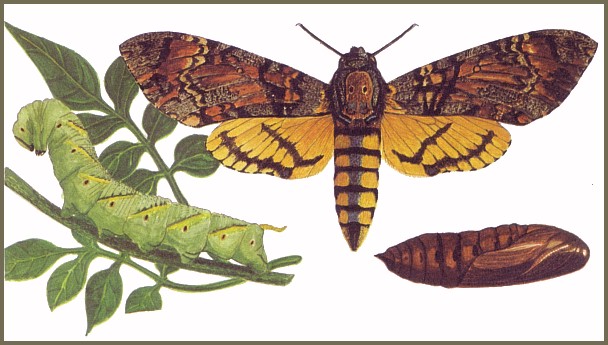
Palaeotropical; Oriental region.
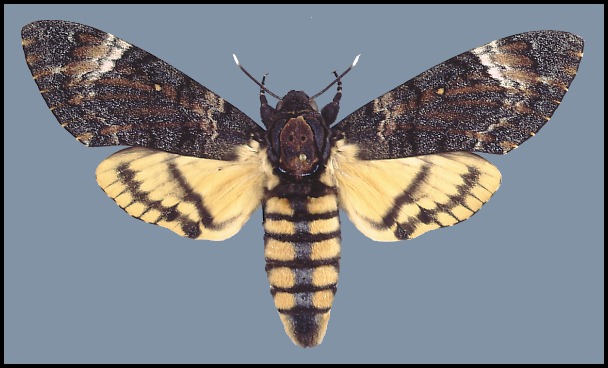
Wingspan 90--120mm. Similar to Acherontia atropos (Linnaeus, 1758) but differs in having two medial bands on the underside of the forewing, instead of one, and usually no dark bands across the ventral surface of the abdomen. The skull-like marking is darker and there is a faint blue tornal dot enclosed by a black submarginal band on the hindwing upperside. The forewing discal spot (stigma) is orange; in Acherontia atropos it is usually white. Variation as in Acherontia atropos.
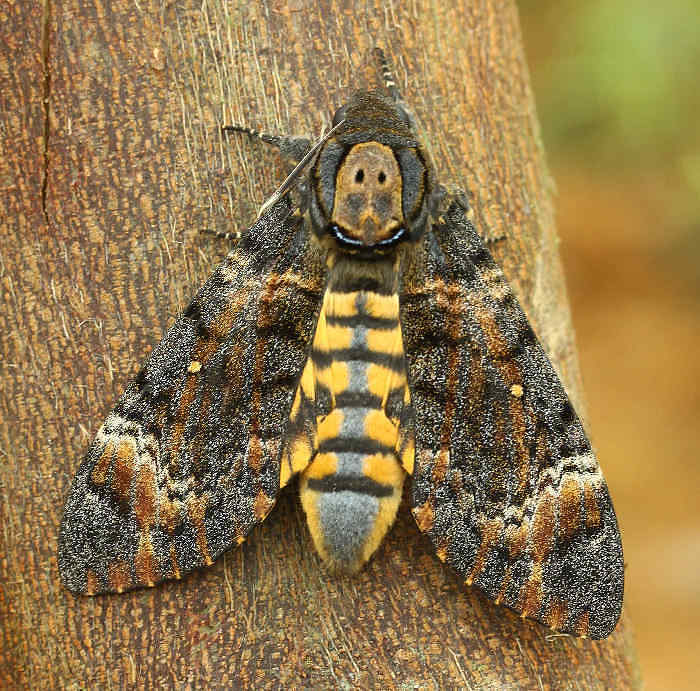
In behaviour, very similar to that of Acherontia atropos. An avid robber of honey in bee hives in Oman (Pittaway, 1993). Although not a regular migrant like Acherontia atropos, limited numbers are found each year throughout the Middle East. Originally it favoured hot, open, low-lying country, either under semi-cultivation, or with oases. However, in recent years it has taken to suburban gardens with ornamental shrubs, such as Volkameria inermis [syn. Clerodendrum inerme] and Tecoma stans.
February, May, July and September, occurring in four generations, although in Saudi Arabia, adults and larvae may be found until November in small numbers (Pittaway, 1979b).
OVUM: Oval, 1.5 x 1.2mm, pale glossy green, changing to yellowish green just before hatching. Laid singly on the under and upper surfaces of leaves on peripheral twigs, usually hatching three to five days later.
LARVA: Full-fed 90--120mm. Trimorphic: green, yellow or brown.
![Full-grown larva of Acherontia styx on Volkameria inermis [syn. Clerodendrum inerme], Ras Tanura, eastern Saudi Arabia. Photo: © Tony Pittaway Full-grown larva of Acherontia styx on Volkameria inermis [syn. Clerodendrum inerme], Ras Tanura, eastern Saudi Arabia. Photo: © Tony Pittaway](a_sty_l2.jpg)
As in Acherontia atropos, the newly-hatched, 5mm-long larvae immediately consume their eggshells. At this stage they are 'frosty' yellowish green with a long, black, fork-tipped horn. In the second instar white lateral stripes and numerous small white tubercles appear, many more than in Acherontia atropos. Additionally, young larvae of Acherontia styx never bear the dorsal, thoracic, thorn-like tubercles so pronounced in that species. As in Acherontia atropos, it is not until after the third moult that the final colours become apparent. Fully-grown larvae closely resemble those of Acherontia atropos except that the dark blue dorsal speckling is more pronounced on the anterior half of each abdominal segment, and the horn is less curved and lacks a reflexed tip.
In colour forms and behaviour, Acherontia styx also resembles the previous species, being, if anything, more lethargic and confining its strip-feeding to two or three shoots. At 40°C, growth is exceedingly rapid, ovum to pupa taking as little as 10 days. Usually found from March to mid-November. (For more information see Harbich (1978a, 1978b, 1980c, 1981).)
Major Hostplants. Solanaceae (especially Lycopersicon, Solanum, Lycium and Withania somnifera) and some Verbenaceae, such as Volkameria inermis [syn. Clerodendrum inerme], a common hedging plant in the Arabian Peninsula (Pittaway, 1981).
Minor Hostplants. Oleaceae, Cucurbitaceae, Fabaceae and Sesamum indicum, and, in the gardens of Saudi Arabia, Spathodea campanulata, Tecoma stans, Tecomaria capensis, Lantana camara, Vitex agnus-castus, Clerodendrum trichotomum and Duranta erecta (Pittaway, 1993). The last also in Iraq.
PUPA: 50--60mm. Similar to, but paler than that of Acherontia atropos. However, unlike that species, rarely formed more than 10cm below the surface of the soil, in a smooth-sided chamber. The main overwintering stage. Very tolerant of extremes of moisture or dryness.
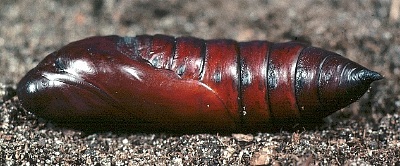
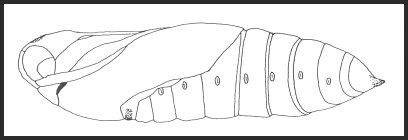
Tachinidae: Drino (Zygobothria) atropivora (Robineau-Desvoidy, 1830), Drino (Zygobothria) ciliata (Wulp, 1881) (Whitcombe & Erzinclioglu, 1989).
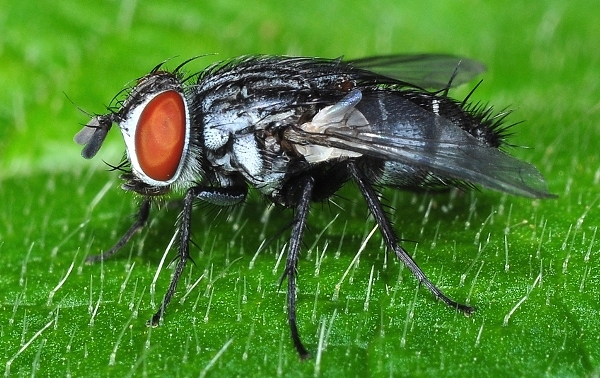
Lower Mesopotamia/Iraq (Watkins & Buxton, 1923; Wiltshire, 1957; Gentry, 1965; Kemal & Koçak, 2018c), Saudi Arabia (Pittaway, 1979b; Wiltshire, 1980a), eastern Oman (Wiltshire, 1977a), western, central and southern Iran (Daniel, 1961; Ghassemi, Alemansoor & Alehossein, 2010) and eastern Afghanistan (Gentry, 1965; Ebert, 1969). As a migrant, it has been found in Turkey, Syria (Wiltshire, 1980b), Israel (Rittner & Biel, 2017) and Jordan (Pittaway, 1993; Müller et al., 2005a; Shadi Emrisi, iNaturalist 2018). Acherontia styx has only recently (1982) spread westwards across Saudi Arabia to Jeddah (Wiltshire, 1986) and Duba (Tabuk Region), and may well colonize the African mainland in the near future, where it has been reported from Al-Bahr al-Ahmar and the Hurghada area (Egyptian Red Sea coast). It has also been recorded from Lower Egypt by Abdelfattah Mabrouk Amer Salem (2022), from several areas of the Cairo Governorate (Youssef ElNahas, iNaturalist 2020), from Dahab in the southern Sinai (Marta Garvaitė, pers. comm. 2023), and it is probably already established in southern Israel (Eilat and Taba). It was first recorded from Eilat in 2017 (Rittner & Biel, 2017; Moshe Neeman, iNaturalist 2024) and later on at Yotvata farther north, and then other localities up to the central Arava valley/Wadi Araba. It has also recently spread south in Oman as far as Salalah, where it now overlaps with Acherontia atropos (Linnaeus, 1758).
Extra-limital range. Pakistan (Gentry, 1965; Rafi et al., 2014; Humairah Hanif et al., 2016), India (Pathania, Sunita Sharma & Gill, 2014), Sri Lanka, Bangladesh, Myanmar, Thailand and Yunnan Province, China.
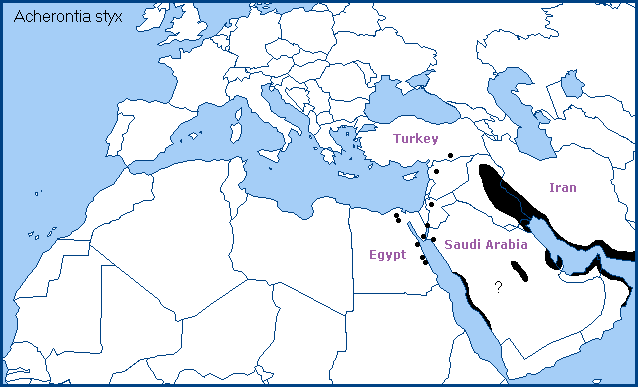
Southern Japan, central and eastern China, Indo-China, Philippines, Malaysia and western Indonesia as subsp. medusa Butler, 1877.
 Return to species list
Return to species list